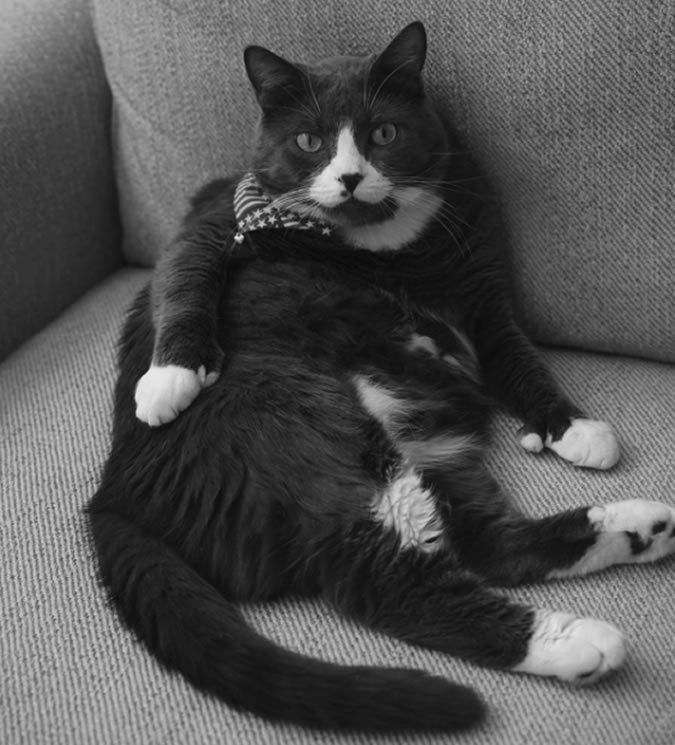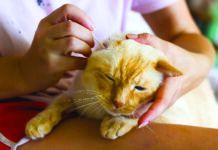
Cats with supernumerary digits (more than the usual number of toes on one or more of their paws) are born with a genetic mutation known as polydactylism. Surprisingly, it’s somewhat common, and many people particularly like these cats.
Polydactylism (from the Greek: poly = many, daktulos = toes or fingers) is a dominant trait, meaning that only one of the parents of kittens born with more than the normal number of toes must carry the gene that is responsible for producing polydactylism. If one parent has extra toes, there is a likelihood that some of the kittens will be polydactyl; and if both parents have supernumerary digits, this increases the probability they will produce all polydactyl kittens.
The number of toes can vary
However, the number of extra toes can vary — and the kittens may not have the exact number of supernumerary digits that their parents have. While it is common to have extra toes on the front paws, extra digits on the hind paws is quite unusual, and having extra toes on all four paws is remarkable.
Many cat lovers consider these cats to be especially appealing and mysterious. To learn more about them, we reached out to Arnold Plotnick, MS, DVM, DACVIM, owner of Manhattan Cat Specialists and a regular contributor to Catnip. “Normally, cats have a total of 18 digits. The front paw has five toes, four toes and one dewclaw (the small toe on the medial side of the foot that doesn’t touch the ground), with four toes on the hind paws,” explains Dr. Plotnick.
“Most polydactyl cats have one or two extra toes on each foot, with the extra toes appearing on the thumb side of the foot. Polydactylism is a common trait among cats. But polydactylism doesn’t affect cats adversely. It offers them no advantages, nor does it yield any disadvantages. If it had disadvantages, polydactyl cats most likely would have died out. It is simply an enchanting quirk.” Dr. Plotnick has a special place in his heart for polydactyl cats because he owns a beautiful polydactyl calico cat named Mittens. Her polydactylism is one of the things that charmed him about her. The Guinness World Records states that a Canadian cat named Jake holds the record in polydactylism with 28 toes.
No special care required
“While some people may worry about these cats catching the extra toes on furnishings, this is rarely a problem,” explains Dr. Plotnick. “The toenails associated with the extra toes tend to be normal nails. However, occasionally the extra toe is incompletely formed and the nail bed is also deformed, which can lead to a claw problem similar to an ingrown or overgrown claw. Like all kitty toenails, the extra ones require regular trimming.”
Polydactyl cats are not considered an actual breed. However, the original unregistered Maine Coon cats had a high incidence of polydactylism — as much as 40 percent — according to Dr. Plotnick. Intriguing folklore was passed on, proclaiming that the extra toes on these cats evolved as a “snowshoe foot” to help Maine Coons walk more effortlessly through the snow. Another reason given for their oversized paws was that they helped the cats to easily catch live fish from streams to bring home to their owners.
Although these folk tales are delightful, Dr. Plotnick says that there is no evidence of polydactylism conferring any natural advantage to cats that are affected. For competition, the Maine Coon breed standard requires a normal foot structure: paws large, round, well-tufted; five toes in front; four in back. As a result, Maine Coon breeders deliberately breed out this “undesirable” trait. However, according to Dr. Plotnick, there is currently a move to reinstate the polydactyl form of the breed in the Netherlands and Belgium. Because some ailurophiles are concerned that unscrupulous breeders could attempt to produce cats with an excessive — and possibly disabling — number of toes on each paw, deliberate breeding of cats for polydactylism remains controversial. Today, all feline breed standards require cats to have the normal number of digits.
Common nicknames
Nicknames include “mitten cats,” “thumb cats” and “boxing cats,” among others. However, they are most commonly known as “Hemingway cats,” named for the writer, Ernest Hemingway. According to Dr. Plotnick, “Hemingway made his home on the small island of Key West, Florida. He shared the island with almost 50 cats, including a six-toed white polydactyl named Snowball given to him by Stanley Dexter, a ship captain and drinking buddy.” According to seafaring legend, cats with extra toes bring a bounty of luck, so that may have been the intention behind Captain Dexter’s gift.
Today, a number of polydactyl cats — some of them descendants of the original Snowball — still live at the Ernest Hemingway Home & Museum in Key West, Florida. After Hemingway’s death in 1961, the cats remained at his home still enjoying the life of luxury, strolling through the gardens, enjoying catnaps in sunny spots, and comfortably lounging around on the furniture. Over the years these famous felines have become a popular attraction, delighting untold numbers of cat loving visitors from around the world. — Jo Singer




